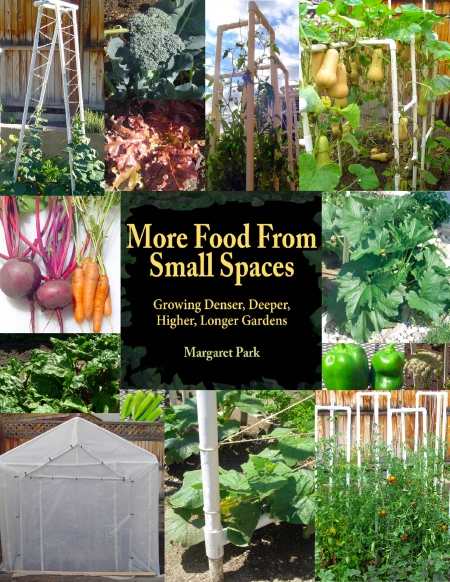More Food from Small Spaces
Growing Denser, Deeper, Higher, Longer Gardens
“Better to eat vegetables and fear no creditors, than eat duck and hide from them,” counsels the Talmud, a book of Jewish teachings. In More Food From Small Spaces, Margaret Park provides a cornucopia of techniques for growing high-yield vegetable crops in tiny plots—methods motivated by the author’s dream of putting wholesome, fresh food on the table while attaining economic security.
Park has been growing vegetables in plots of varying sizes for more than thirty years. Using techniques and tools she developed, she is able to grow more vegetables in an eight-by-twenty-four-foot patch than she used to get out of a garden three times that size.
Park begins with a description of her unique garden plot—the “center square”—which provides more than thirty-five percent additional growing space than traditional plot designs. Remaining chapters cover such topics as soil enhancement, benefits of the Bokashi composting medium (including instructions for making it), how to build garden supports and greenhouses from PVC pipe, methods for successfully saving vegetable seeds, and a host of other green-thumb tips. For example, Park suggests, “Vessels holding water can be circled around frost tender plants to help them withstand the frosty nights.” And, “winter squashes should be left on the vine until after a frost when the plants place their final sugars into the fruits.”
More Food From Small Spaces is clearly written, well organized, and chock-full of photographs and step-by-step instructions that make implementing Park’s techniques a snap. And her book is apparently cutting edge. Popular ads tell us that “small is the new big.” If that saying is true, then More Food is huge.
The book’s general appeal is marred, however, by repeated typographical errors, and it ends with a disappointingly brief chapter on techniques for making food last: canning, freezing, and dehydrating. More troubling is that, while most of Park’s methods have been well researched, her discussion of “structuring water with a magnetic field” has not been similarly vetted. “I’m offering these ideas here,” she explains, “without knowing if they really work because they’re easy and inexpensive to accomplish.”
Nonetheless, gardeners who believe they don’t need another book on the horticulture shelf may want to reconsider, as Park’s high-yield techniques are worth far more than the purchase price of her book. As Alice B. Toklas reminded us, “There is nothing … as satisfactory or as thrilling as gathering the vegetables one has grown.” Now, with the aid of Park’s More Food From Small Spaces, even urban dwellers can experience the joy of harvesting abundant, fresh vegetables from economical gardens they cultivate in tiny spaces.
Reviewed by
Nancy Walker
Disclosure: This article is not an endorsement, but a review. The publisher of this book provided free copies of the book and paid a small fee to have their book reviewed by a professional reviewer. Foreword Reviews and Clarion Reviews make no guarantee that the publisher will receive a positive review. Foreword Magazine, Inc. is disclosing this in accordance with the Federal Trade Commission’s 16 CFR, Part 255.

